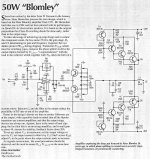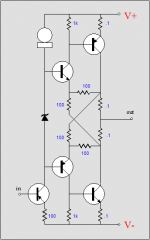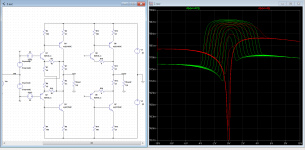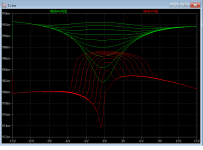Another opamp driven power amp.
R22, R32 look suspicious.
It think it must read R56 so 0.56 Ohm.
See also http://worldtracker.org/media/libra.... High Performance Audio Power Amplifiers.pdf
And here https://www.flickr.com/photos/suikerbuik/with/3944876995/
This may be related http://www.google.com/patents/DE19637292B4?cl=de
And this one http://www.keith-snook.info/wireles.../New Approach to class B Amplifier Design.pdf
And yes, the 56R must read 0.56R (Dutch design, best design 🙂)
Last edited:
In link 4 we have our wingspread in 1971 so this goes back a long way.
And from this paper I quote:
Possible applications
The performance of an amplifier of this
calibre is, in my opinion, wasted in a
conventional audio set-up. In most cases,
the transducers will be the weakest link.
Speakers got a lot better the last 40 years.
Anyway, the thought that the speaker is the weakest link is as old as HiFi and i would not try to build better speakers if that where not the case in one measure or the other.
The real problem is how you set them up and the room acoustics.
Also not all recordings are done well.
CD is maybe perfect but many recordings are not.
Anyway, the thought that the speaker is the weakest link is as old as HiFi and i would not try to build better speakers if that where not the case in one measure or the other.
The real problem is how you set them up and the room acoustics.
Also not all recordings are done well.
CD is maybe perfect but many recordings are not.
Speakers got a lot better the last 40 years.
Anyway, the thought that the speaker is the weakest link is as old as HiFi and i would not try to build better speakers if that where not the case in one measure or the other.
The real problem is how you set them up and the room acoustics.
Also not all recordings are done well.
CD is maybe perfect but many recordings are not.
But he is not right, improving the amplifier also improves the reproduction of 'less'-good other components (including the loudspeaker). Also, when you are so aware of the fact that other components need the attention, why not work on those? Any way, it sounds like a complaint, where it is just an opportunity, the same opportunity still exists.
My speakers have around 0.5% second and 0.1% third at cruising level between 50Hz and 20kHz. That maybe already under the perception level.
Here is a study from Geddes and Lee that at higher levels the distortion in the ear may dominate :
http://www.gedlee.com/downloads/AES06Gedlee_ll.pdf
Here is a study from Geddes and Lee that at higher levels the distortion in the ear may dominate :
http://www.gedlee.com/downloads/AES06Gedlee_ll.pdf
Maybe someone can simulate it.
This is interesting too :
Loudspeakers: Effects of amplifiers and cables - Part 5 | EE Times
This is interesting too :
Loudspeakers: Effects of amplifiers and cables - Part 5 | EE Times
Maybe someone can simulate it.
I will do it at night.
I have also been occupied recently by this matter of linearise the CFP output stage. but I follow a different route.
I will simulate the circuit that you post, and will post the result.
The wingspread of the #568 circuit does not show a great improvement , the gain is higher that the simple CFP but it has lower temperature stability, the resistors values used in #568 are also very high unless the power transistors are darlington.
It has also the gm-doubling effect as the normal CFP.
It has also the gm-doubling effect as the normal CFP.
Attachments
This is the wingspread of the CFP that I have been developing in green, against the circuit from #568 in red. The gain is even higher and there is no gm-doubling, the temperature stability is better than the simple CFP.
The upper traces are at quiescent current of 350mA.
I am designing a pcb for a amplifier with this output stage, but until the end of the year will not have any time left for further developments.
The upper traces are at quiescent current of 350mA.
I am designing a pcb for a amplifier with this output stage, but until the end of the year will not have any time left for further developments.
Attachments
It seems to be not that easy....
Actually the solution for the gm-doubling in the CFP is very simple. I found two possible solutions
Why not. Everybody needs a good amp and i am no specialist in that.
Maybe it could help Ricardo.
Maybe it could help Ricardo.
- Status
- Not open for further replies.
- Home
- Source & Line
- Analogue Source
- JG´s Nobrainer and Nobrainer Discrete



